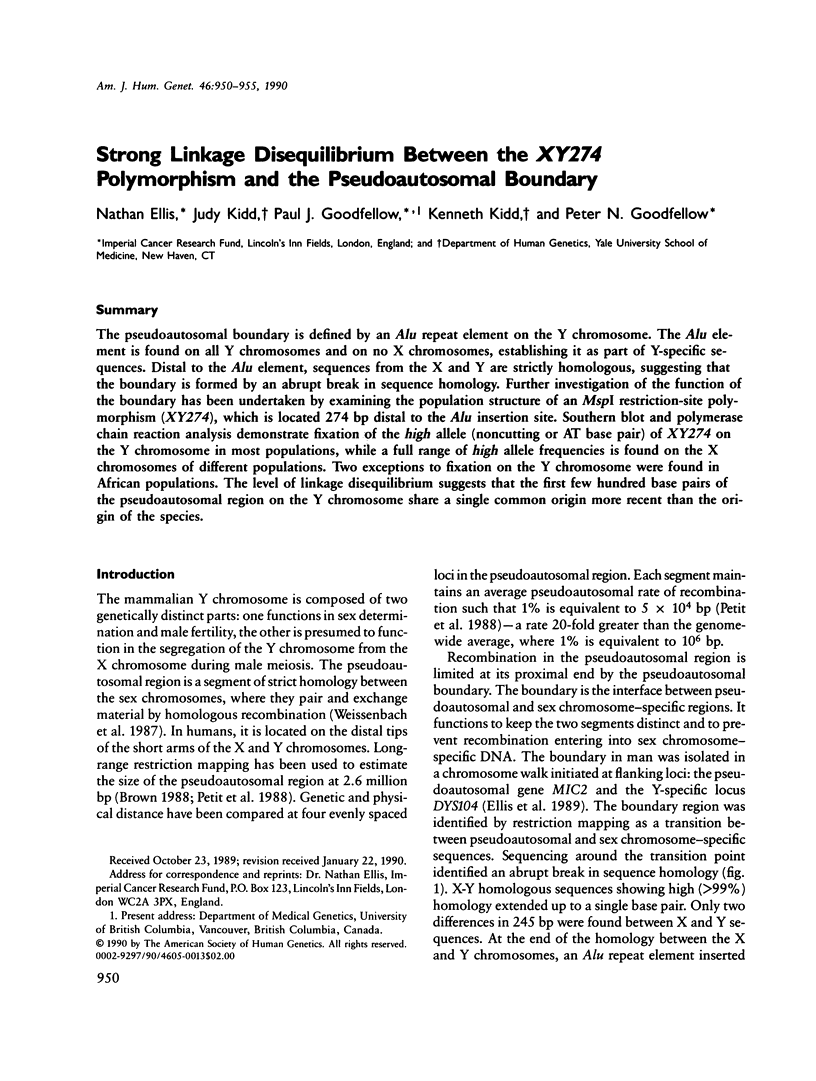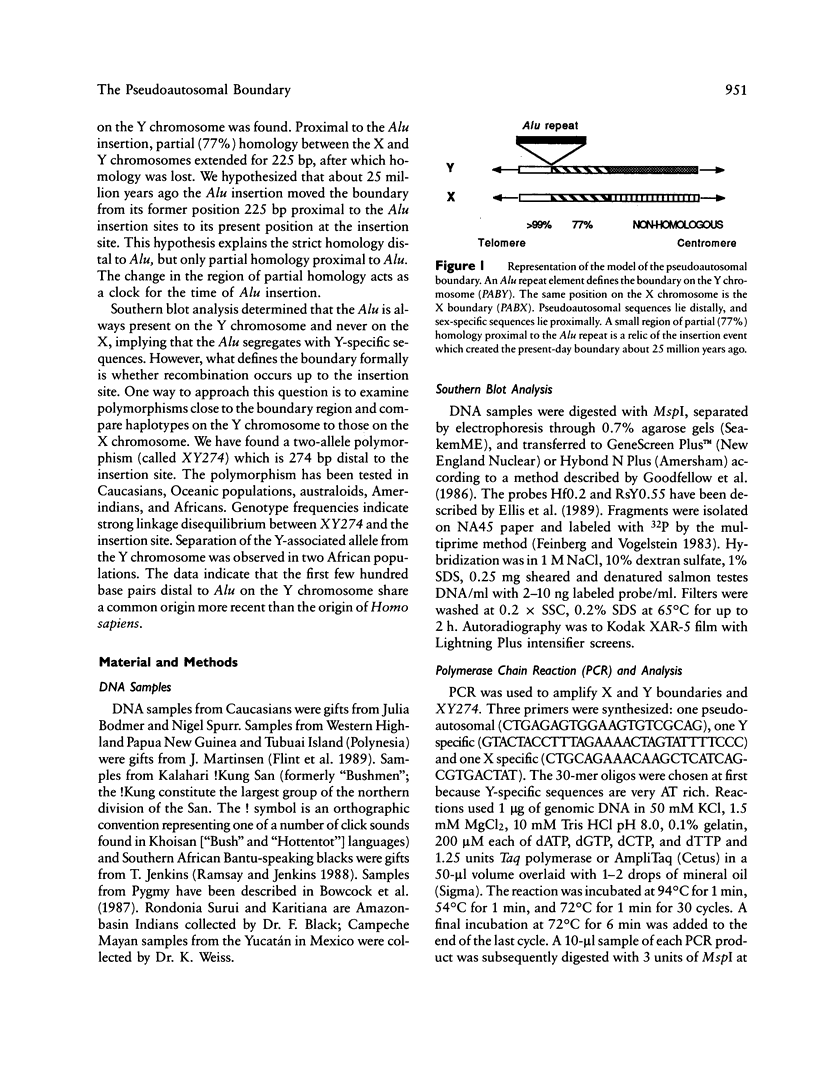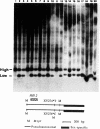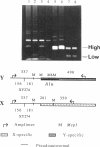Abstract
The pseudoautosomal boundary is defined by an Alu repeat element on the Y chromosome. The Alu element is found on all Y chromosomes and on no X chromosomes, establishing it as part of Y-specific sequences. Distal to the Alu element, sequences from the X and Y are strictly homologous, suggesting that the boundary is formed by an abrupt break in sequence homology. Further investigation of the function of the boundary has been undertaken by examining the population structure of an MspI restriction-site polymorphism (XY274), which is located 274 bp distal to the Alu insertion site. Southern blot and polymerase chain reaction analysis demonstrate fixation of the high allele (noncutting or AT base pair) of XY274 on the Y chromosome in most populations, while a full range of high allele frequencies is found on the X chromosomes of different populations. Two exceptions to fixation on the Y chromosome were found in African populations. The level of linkage disequilibrium suggests that the first few hundred base pairs of the pseudoautosomal region on the Y chromosome share a single common origin more recent than the origin of the species.
Full text
PDF





Images in this article
Selected References
These references are in PubMed. This may not be the complete list of references from this article.
- Bowcock A. M., Bucci C., Hebert J. M., Kidd J. R., Kidd K. K., Friedlaender J. S., Cavalli-Sforza L. L. Study of 47 DNA markers in five populations from four continents. Gene Geogr. 1987 Apr;1(1):47–64. [PubMed] [Google Scholar]
- Brown W. R. A physical map of the human pseudoautosomal region. EMBO J. 1988 Aug;7(8):2377–2385. doi: 10.1002/j.1460-2075.1988.tb03082.x. [DOI] [PMC free article] [PubMed] [Google Scholar]
- Cavalli-Sforza L. L., Piazza A., Menozzi P., Mountain J. Reconstruction of human evolution: bringing together genetic, archaeological, and linguistic data. Proc Natl Acad Sci U S A. 1988 Aug;85(16):6002–6006. doi: 10.1073/pnas.85.16.6002. [DOI] [PMC free article] [PubMed] [Google Scholar]
- Cooper D. N., Krawczak M. Cytosine methylation and the fate of CpG dinucleotides in vertebrate genomes. Hum Genet. 1989 Sep;83(2):181–188. doi: 10.1007/BF00286715. [DOI] [PubMed] [Google Scholar]
- Ellis N. A., Goodfellow P. J., Pym B., Smith M., Palmer M., Frischauf A. M., Goodfellow P. N. The pseudoautosomal boundary in man is defined by an Alu repeat sequence inserted on the Y chromosome. Nature. 1989 Jan 5;337(6202):81–84. doi: 10.1038/337081a0. [DOI] [PubMed] [Google Scholar]
- Feinberg A. P., Vogelstein B. A technique for radiolabeling DNA restriction endonuclease fragments to high specific activity. Anal Biochem. 1983 Jul 1;132(1):6–13. doi: 10.1016/0003-2697(83)90418-9. [DOI] [PubMed] [Google Scholar]
- Flint J., Boyce A. J., Martinson J. J., Clegg J. B. Population bottlenecks in Polynesia revealed by minisatellites. Hum Genet. 1989 Oct;83(3):257–263. doi: 10.1007/BF00285167. [DOI] [PubMed] [Google Scholar]
- Goodfellow P. J., Darling S. M., Thomas N. S., Goodfellow P. N. A pseudoautosomal gene in man. Science. 1986 Nov 7;234(4777):740–743. doi: 10.1126/science.2877492. [DOI] [PubMed] [Google Scholar]
- Petit C., Levilliers J., Weissenbach J. Physical mapping of the human pseudo-autosomal region; comparison with genetic linkage map. EMBO J. 1988 Aug;7(8):2369–2376. doi: 10.1002/j.1460-2075.1988.tb03081.x. [DOI] [PMC free article] [PubMed] [Google Scholar]
- Ramsay M., Jenkins T. Alpha-globin gene cluster haplotypes in the Kalahari San and southern African Bantu-speaking blacks. Am J Hum Genet. 1988 Oct;43(4):527–533. [PMC free article] [PubMed] [Google Scholar]
- Weissenbach J., Levilliers J., Petit C., Rouyer F., Simmler M. C. Normal and abnormal interchanges between the human X and Y chromosomes. Development. 1987;101 (Suppl):67–74. [PubMed] [Google Scholar]




